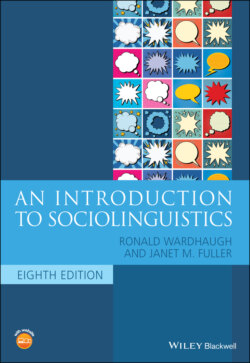Читать книгу An Introduction to Sociolinguistics - Ronald Wardhaugh, Janet M. Fuller - Страница 30
Overview of the Book
ОглавлениеAs should now be apparent, the study of sociolinguistics is deeply concerned with aspects of scholarship which are sometimes labeled theoretical and others which are said to be applied. At the very least, sociolinguistics is a socially relevant variety of linguistics, but it is probably much more.
These chapters are organized within four general topics. However, there will be considerable moving back and forth with cross‐referencing within topics and among topics. Inter‐relationships are everywhere, and our themes will recur across the discussions of dialects, multilingualism, discourse, and social justice.
Part I, Languages, Communities, and Contexts, deals with some traditional language issues: trying to separate languages from dialects and looking at types of regional and social variation within languages (chapter 2); trying to figure out what kinds of ‘groups’ are relevant when we study language use (chapter 3); and looking at the role of context in language use and interpretation (chapter 4).
Part II, Theory and Methods, looks at three broad approaches to research in sociolinguistics and how they are carried out. Chapter 5 deals with variationist sociolinguistics, chapter 6 ethnographic approaches, and chapter 7 discourse analytic research.
Part III, Multilingual Matters, addresses both macro‐ and micro‐sociolinguistic topics in the study of multilingualism. These topics include interactional as well as societal patterns of multilingualism (chapter 8), structural consequences of language contact (chapter 9), and language in national, transnational, global, and digital contexts (chapter 10).
Part IV, Sociolinguistics and Social Justice, looks into three areas of life in which sociolinguistics offers us some hope of understanding pressing problems (and which some sociolinguists argue require our deliberate intervention). Language, gender, and sexuality, one of the great ‘growth areas’ in language study, is the first of these (chapter 11). Sociolinguistics and education is the second (chapter 12). Language planning and policy issues, including the spread of English world‐wide and the ‘death’ of many languages, is the third (chapter 13).
